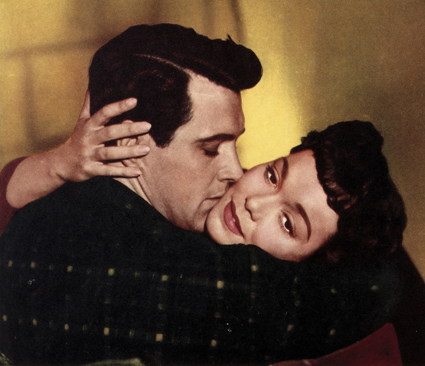douglas sirk – the high art of melodrama
wendy haslem: douglas sirk, hollywood filmmaker

Rock Hudson, Jane Wyman, All That Heaven Allows, Douglas Sirk
IN THE 1950S THE FILMS OF DOUGLAS SIRK WERE CONDEMNED AND DISMISSED BY SOME REVIEWERS AS LOW BROW, POPULAR FANTASIES FOR WOMEN—OVERLY DRAMATIC, HYPER-EMOTIONAL AND SENTIMENTAL. IN THE SATURDAY REVIEW, ARTHUR KNIGHT DESCRIBED IMITATION OF LIFE (1959) AS “LIFE AS [AUDIENCES] WOULD LIKE TO BELIEVE IT, AND IT MAKES GOOD MOVIE MATERIAL—AT LEAST FOR A MATINEE.” THE MONTHLY FILM BULLETIN’S REVIEW IDENTIFIED THE FILM’S DUAL FORCES, DESCRIBING IT AS “HIGH-CLASS PULP FICTION” AND SUGGESTING THAT, “ITS ONSLAUGHT ON THE EMOTIONS IS ALMOST ENTIRELY SYNTHETIC…ITS ATTITUDE TOWARD ITS RACIAL PROBLEM IS DEBASED AND COMPROMISED.”
However, Sirk’s melodramas were embraced in the 1980s and ‘read against the grain’ as rich and revealing film texts that were simultaneously reflecting and critiquing the culture of their production. By developing intricate narrative patterns encouraging identification and catharsis, Sirkian melodramas were seen to function as ‘safety valves’ for patriarchy, siphoning off cultural anxieties.
Douglas Sirk was an art historian when he began his career as a director of German theatre and cinema during the 1920s. Influenced by the style of German Expressionism, particularly its projection of a character’s psyche onto an artificial external space, Sirk brought this vision to Hollywood, and this aesthetic defined the melodramas he directed for Universal Studios. He was also inspired by the politicised theatre developed by Brecht and used techniques of ‘distanciation’ to provoke an active, critical spectator. As a result, the universe created in Sirk’s melodramas deliberately breaks with realist conventions, creating artificial worlds. An excessive mise-en-scène is constructed with a use of frames within frames to separate characters; mirrors and reflective surfaces to suggest split, or multiple identities; spaces that are segregated; and vivid colours to highlight character traits. The melodramas explore time in narrative, prioritising accidents, interruptions, coincidence, fate and particularly the trope of being ‘too late.’
Sirk’s films feature a fascination with failure. Magnificent Obsession (1954) features an array of plot twists and parallel worlds beginning with the resuscitation of the rogue playboy and jet boat pilot Bob Merrick (Rock Hudson) at the expense of the life of the respected Dr Wayne Phillips. The film details the anguish and affection of a burgeoning romance between Helen Phillips (Jane Wyman) a character who introduces herself to Bob as “Mrs Wayne Phillips.” While trying to escape Bob’s clutches, Helen is hit by a car, resulting in a blindness that can only be cured by Bob’s return to his earlier career—neurosurgery. Sirk’s All That Heaven Allows (1955) uses the same stars to explore the controversy of a ‘May/December’ relationship, with Jane Wyman as Cary, the older woman battling resistance to her affair with Ron (Rock Hudson). The image that resonates most from this film is the reflection of Cary framed in the screen of a television her son and daughter have bought her for Christmas, hoping to distract her from unbridled passion.
Films like Imitation of Life (1959) use ‘spatial narration’ to define the importance of space and power in the cinema. Sirk’s spaces carry reference to class, status, wealth and dominance, symbolising exclusion, division, restriction and segregation. This is clear in the opening shots of Imitation of Life as Lora Meredith (Lana Turner) searches for her child on the boardwalk. Annie Johnson (Juanita Moore) and Sarah Jane (Susan Kohner) are looking after Susie (Sandra Dee) in the shade beneath. When they share an apartment, Annie and Sarah Jane are relegated to the broom cupboard, a space that Lora describes as:
“a little place off the kitchen…but you could hardly call it a room.” In their country home Lora and Susie have access to the more formal public rooms, while Annie and Sarah Jane are confined to the kitchen and the rear of the house. Sirk highlights the dislocation and segregation with an image of the rebellious Sarah Jane speaking with a Southern twang as she delivers crawfish to guests, carrying the plate on her head.
While Sirk’s Hollywood melodramas were misunderstood on their release, his film work continues to exert a significant and lasting impression on contemporary visual culture. The impact is evident in remakes like Far From Heaven (Todd Haynes, 2002) and on the small screen in the series Mad Men (2007-), but these revisions are never quite as aesthetically vibrant, narratively complex or as incisive in their cultural critique as Sirk’s progressive ouvre. Douglas Sirk’s films are so loaded they almost split apart at the seams.
Douglas Sirk: King of Hollywood Melodrama, Madman Entertainment,
Courtesy of Madman Entertainment and in celebration of our 101st edition, RealTime is offering a lucky reader a ravishing cinematic giveaway: a 9-DVD box set of the great films of the 1950s master of aesthetically and socially incisive Hollywood melodramas, Douglas Sirk. To compete for the Sirk DVD set go to: www.realtimearts.net/sirk_survey.html
RealTime issue #101 Feb-March 2011 pg. 28






